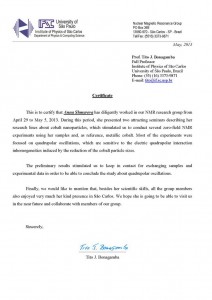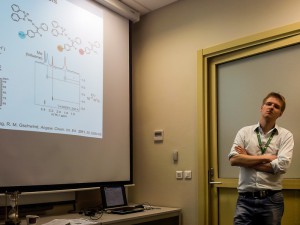- Информация о материале
- Просмотров: 1230
Анна Шмырева прошла обучение в университете Сан-Паулу, Бразилия, и получила сертификат.
- Информация о материале
- Просмотров: 1562
Benjamin Koeppe, Erik T. J. Nibbering, Peter M. Tolstoy
«NMR and FT-IR studies on the association of derivatives of thymidine, adenosine, and 6-N-methyl-adenosine in aprotic solvents»
Z. Phys. Chem. 2013, accepted.
Abstract:
Associates of 3’,5’-O-TBDMS protected derivatives of deoxynucleosides adenosine, 6-N-methyl-adenosine and thymidine (henceforward simply addressed by their parents’ names) and further model systems in dichloromethane and Freon (CDClF2/CDF3) solu-tions are studied at low temperatures by 1H NMR and FT-IR spectroscopy. N…N distances in hydrogen bonds are estimated from chemical shifts of protons in hydrogen bonds employing geometric and spectroscopic hydrogen bond correlations. These distances are in turn employed to derive NH stretching frequencies from IR spectroscopic hydrogen bond correlations which may be compared to corresponding experimental results. Three isomeric hydrogen bonded dimers of thymidine are characterized in Freon solution at 120 K. Binary associates of thymidine and a series of pyridines are studied; estimated N…N distances in the range of 3.08 to 2.85 Å are qualitatively correlated to shifts of NH stretching bands where in all cases considerable contributions are found in the spectral region below 3000 cm-1. For adenosine, three isomeric binary associates with 4-nitrophenol are found allowing for an assessment of site-specific acceptor capabilities. In associates of thymidine and adenosine, Watson-Crick and Hoogsteen type 1:1 associates (estimated N…N distances of 2.85 and 2.90 Å) as well as 2:1 associates bearing only marginally longer (i.e. weaker) H-bonds could be characterized. Two 1:1 associates between thymidine and 6-N-methyl-adenosine are desctibed that are exclusively bonded via NH…N bridges of about 2.97 and 3.08 Å for Watson-Crick and Hoogsteen sites, respectively, which leads to the conclusion that cooperative effects among coupled NH…O and NH…N hydrogen bonds in A-T base pairs are significant as formation of the NH…O bond induces a contraction of around 0.15 Å in the neighboring NH…N bond.
- Информация о материале
- Просмотров: 1089
Состоялся доклад Нильса Соргенфрая, аспиранта из университета Регенсбурга, Германия.
- Информация о материале
- Просмотров: 1194
В первый же месяц работы РЦ было утверждено 59 проектов и зарегистрировано 76 пользователей.
Всего в апреле выполнено 1032 заявки на сервисные измерения.
Измерено:
- 985 спектров 1H
- 244 спектра 13C
- 114 спектров DEPT
- 6 спектров COSY
- 8 спектров NOESY
- 5 спектров 31P
- 9 спектров 19F
Кроме того, выполнено 42 заявки на выполнение работ, измерения по которым в сумме заняли 311 часов.
- Информация о материале
- Просмотров: 1282
B. Koeppe, J. Guo, P.M. Tolstoy, G. Denisov, H.-H. Limbach
«Solvent and H/D Isotope Effects on the Proton Transfer Pathways in Heteroconjugated Hydrogen-Bonded Phenol-Carboxylic Acid Anions Observed by Combined UV-Vis and NMR Spectroscopy»
J. Am. Chem. Soc. 2013, accepted.

ABSTRACT: Heteroconjugated hydrogen-bonded anions A···H···X- of phenols (AH) and carboxylic/inorganic acids (HX) dissolved in CD2Cl2 and CDF3/CDF2Cl have been studied by combined low-temperature UV-Vis and 1H/13C NMR spectroscopy (UVNMR). The systems constitute small molecular models of hydrogen-bonded cofactors in proteins such as the photoactive yellow protein (PYP). Thus, the phenols studied include the PYP cofactor 4-hydroxycinnamic acid methyl thioester, and the more acidic 4-nitrophenol and 2-chloro-4-nitrophenol which mimic electronically excited cofactor states. It is shown that the 13C chemical shifts of the phenolic residues of A···H···X-, referenced to the corresponding values of A···H···A-, constitute excellent probes for the average proton positions. These shifts correlate with those of the H-bonded protons, as well as with the H/D isotope effects on the 13C chemical shifts. A combined analysis of UV-Vis and NMR data was employed to elucidate the proton transfer pathways in a qualitative way. Dual absorption bands of the phenolic moiety indicate a double-well situation for the shortest OHO hydrogen bonds studied. Surprisingly, when the solvent polarity is low the carboxylates are protonated whereas the proton shifts towards the phenolic oxygens when the polarity is increased. This finding indicates that because of stronger ion-dipole interactions small anions are stabilized at high solvent polarities and large anions exhibiting delocalized charges at low solvent polarities. It also explains the large acidity difference of phenols and carboxylic acids in water, and the observation that this differences is strongly reduced in the interior of proteins when both partners form mutual hydrogen bonds.







